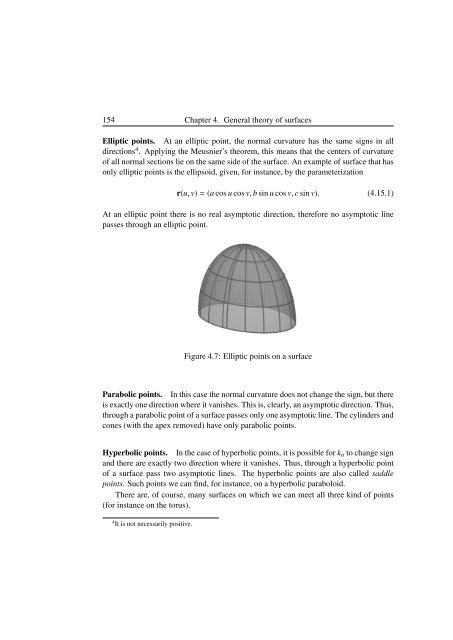Blaga P. Lectures on the differential geometry of - tiera.ru
Blaga P. Lectures on the differential geometry of - tiera.ru
Blaga P. Lectures on the differential geometry of - tiera.ru
Create successful ePaper yourself
Turn your PDF publications into a flip-book with our unique Google optimized e-Paper software.
154 Chapter 4. General <strong>the</strong>ory <strong>of</strong> surfaces<br />
Elliptic points. At an elliptic point, <strong>the</strong> normal curvature has <strong>the</strong> same signs in all<br />
directi<strong>on</strong>s 4 . Applying <strong>the</strong> Meusnier’s <strong>the</strong>orem, this means that <strong>the</strong> centers <strong>of</strong> curvature<br />
<strong>of</strong> all normal secti<strong>on</strong>s lie <strong>on</strong> <strong>the</strong> same side <strong>of</strong> <strong>the</strong> surface. An example <strong>of</strong> surface that has<br />
<strong>on</strong>ly elliptic points is <strong>the</strong> ellipsoid, given, for instance, by <strong>the</strong> parameterizati<strong>on</strong><br />
r(u, v) = (a cos u cos v, b sin u cos v, c sin v). (4.15.1)<br />
At an elliptic point <strong>the</strong>re is no real asymptotic directi<strong>on</strong>, <strong>the</strong>refore no asymptotic line<br />
passes through an elliptic point.<br />
Figure 4.7: Elliptic points <strong>on</strong> a surface<br />
Parabolic points. In this case <strong>the</strong> normal curvature does not change <strong>the</strong> sign, but <strong>the</strong>re<br />
is exactly <strong>on</strong>e directi<strong>on</strong> where it vanishes. This is, clearly, an asymptotic directi<strong>on</strong>. Thus,<br />
through a parabolic point <strong>of</strong> a surface passes <strong>on</strong>ly <strong>on</strong>e asymptotic line. The cylinders and<br />
c<strong>on</strong>es (with <strong>the</strong> apex removed) have <strong>on</strong>ly parabolic points.<br />
Hyperbolic points. In <strong>the</strong> case <strong>of</strong> hyperbolic points, it is possible for kn to change sign<br />
and <strong>the</strong>re are exactly two directi<strong>on</strong> where it vanishes. Thus, through a hyperbolic point<br />
<strong>of</strong> a surface pass two asymptotic lines. The hyperbolic points are also called saddle<br />
points. Such points we can find, for instance, <strong>on</strong> a hyperbolic paraboloid.<br />
There are, <strong>of</strong> course, many surfaces <strong>on</strong> which we can meet all three kind <strong>of</strong> points<br />
(for instance <strong>on</strong> <strong>the</strong> to<strong>ru</strong>s).<br />
4 It is not necessarily positive.












